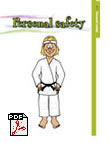- TOOL KITS
- A. The NEXT Step
- B. Promoting Independence
- C. Phone Apps
- D. Return to Work
- E. Motivational Interviewing
- F. Paediatric Brain Injury Rehabilitation Resources
- a) Introduction
- 0. Introduction
- 1. Transition
- 2. The transition wheel
- 3. Walking around the transition wheel
- 4. The transition wheel interview
- 5 . Using this kit
- 6 . Web resources
- b) Working together
- 7. My role
- 8 . My family's role
- 9. My case manager's role
- c) What can I do?
- 10. Who, where, what? The Services I receive
- 11. Accommodation
- 12. Driving
- 13.Alcohol and drugs
- 14. Social and recreational activities
- 15. Health and well-being
- 16. Relationships and friendships
- 17. Sexuality
- 18. Personal safety
- 19. Complaints/rights
- 20. Legal issues
- 21. Centrelink
- 22. Financial
- 23. Shopping
- 24. Employment, training and tertiary education
18. Personal safety
As you become more independent and start to do more things on your own, you will need to make sure that you are safe whilst doing these things. It sounds boring, but your parents will probably find it easier to let you try more things if they feel that you will be safe.
Personal Safety Plan
One way to be safer is to have a Personal Safety Plan. It is hard to know when you will need help, so it is a good idea to know who to contact and how to contact them ‘just in case’. A Personal Safety Plan is all about planning ahead who to contact if you feel unsafe and need some help.
Here is how to create a Personal Safety Plan:
1. Sit down with your parents or your case manager and work out who you would contact if you needed help. Your contacts should be people who you really trust and that you can contact anytime of the day. It is important to have at least three contact people, to give you more chance of getting in touch with one of them.
2. Find a card that can fit into your wallet or purse. Write down the names and contact numbers of these people on the card. This card is your Personal Safety Plan.
3. Make another copy of the names and numbers and leave this copy by your telephone at home. (This is just in case you loose your card or if you feel unsafe or need help while you are at home).
4. Put the Personal Safety Plan straight into your wallet or purse to make sure that you always take it with you when you go out.
5. Decide what safety equipment you may need to stay safe. This might include: a. Telephone b. Mobile telephone c. Duress or panic alarm d. Personal organiser. Learn how to use this equipment.
6. In case you forget your Personal Safety Plan, talk about other people you know who would be safe to ask for help if you are out and about and need help. These people might be a policeman or policewomen, fireman, shop assistant or security guard.
There are many situations that may come up where you need to think about how to keep yourself safe. While you are sitting down working out your Personal Safety Plan try to think of some situation that may come up, when you may need a safety plan.
Some suggestions for these situations are:
- You miss the bus you usually take.
- You get on the wrong train and get lost.
- Your home alone and a fire starts.
- Someone you do not know starts to talk to you and makes you feel uncomfortable.
Talk about what you might do in these situations. Perhaps even practice your plan in some of these situations to see if it is the right plan for you.


